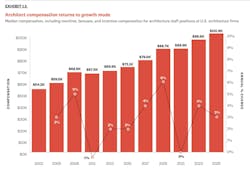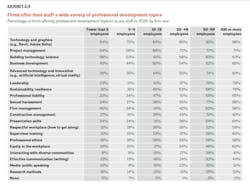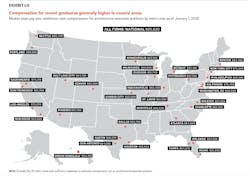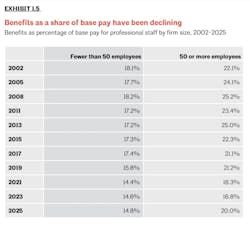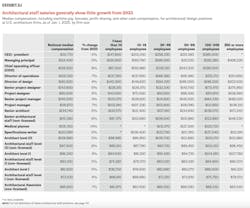Architect compensation slowed from 2023 to 2025, but still closely aligned with increases for all private-sector workers when measured over a decades-long span, according to the 2025 edition of the AIA Compensation & Benefits Report, whose findings the American Institute of Architects released yesterday.
“As staffing shortages at architecture firms have eased, the pressure to add new positions across the profession has lessened,” said Michele Russo, Vice President, Research at AIA, in a prepared statement. “Consequently, architect compensation grew at a slower pace, increasing by less than 3 percent annually between 2023 and 2025.” The national average for all firms and architect associate positions stood at $101,900. The 194-page Report provides detailed breakdowns, by job classification and metro tracked.
Compensation gains were greater for architects who are non-licensed recent graduates, or who have more specialized roles at their firms, such as medical planners and specification writers, the only two job cohorts with double-digit percentage increases over the past two years. AIA also found that, since 2002, architect compensation had grown by 88%, or about the same percentage increase over that period for professional and related positions for all private-sector jobs.
The Report is based on responses from 817 architecture firms with 13,227 employees at 1,376 locations in 45 metros and 34 states. It reveals wide compensation variability across the country: of the 34 metropolitan areas where AIA was able to accurately compile data for architectural associate positions, median compensation—defined as base pay plus cash incentives and bonuses—in the metro area with the highest compensation was 25% above the national level. At the other extreme, median compensation in the metro area with the lowest median compensation was almost 20% below the national level.
Five of the 10 cities with the highest pay for architect associates were in the West. Areas with the highest entry-level compensation often are those with higher costs of living.
A range of compensatory benefits offered
Over the past two decades, the value of benefits as a share of compensation has been drifting down from 19% to 16%. Benefits provided by larger firms averaged 20% of employee compensation and smaller firms contributing just under 15%.
Firms continued offering their employees a range of fringe benefits in 2024. Nearly all large firms reported offering bereavement leave, casual dress, paid maternity leave, and an employee assistance program (EAP). In contrast, small firms were likelier to report offering pet- and child-friendly offices.
As in past years, nearly all firms reported offering employees medical coverage in 2024, and most also offered dependent medical coverage. Overall, the average amount that firms contributed to the premiums for both employee and dependent coverage remained generally steady from 2022, averaging 83% for employee coverage across firms of all sizes and varying from 33% to 59% for dependent coverage, depending on firm size.
Nearly all large firms continued to offer vision care insurance, life insurance, long-term and short-term disability insurance, health care flexible spending accounts (health care FSAs), and dependent care accounts in 2024. Most mid-size firms offer these benefits as well, most notably vision care insurance, while small firms are less likely to offer these additional insurances and accounts.
Remote work is prevalent
Discretionary annual bonuses were the most popular type of bonus offered at architecture firms in 2024, offered by more than two-thirds of all firms. Performance bonuses were offered by nearly half of firms of all sizes, while bonuses for obtaining professional certification(s) and discretionary spot bonuses were generally offered by at least one-third of firms.
The firms that tracked this information reported that senior full-time employees worked an average of 43 hours a week, other full-time employees an average of 40 hours, part-time employees an average of 16 hours, and contract employees an average of 4 hours per week. An average of 70% of staff (and 82% at large firms) work remotely in some capacity.
Architect firms also compensate their associates in non-monetary ways. More than three-quarters of large firms reported offering mentorship programming, and the share of large firms offering transparent career path opportunities rose from 69% to 75%. And while less than half of firms of all sizes reported offering specific transparent promotion and compensation practices in 2024, the share of firms of all sizes offering this support increased from 2022, most notably at small firms, where it increased by 7 percentage points.
More than half of the responding firms hired students for part-time work, a number that rises to 78% for large firms. Large firms were more likely to report hiring students working toward bachelor’s and master’s degrees in 2024.
More than half of large firms reported that they developed or sustained an internal values-based employee committee and/or resource group (e.g., EDI Committee, Women’s Committee, LGBTQIA+ Committee) in 2024 (62%) and hired diverse candidates across all leadership roles (52%). However, the share of large firms that provided training and/or resources in intercultural competence to all employees declined significantly compared to 2022, from 57% to 44%.
About the Author

John Caulfield
John Caulfield is Senior Editor with Building Design + Construction Magazine.

